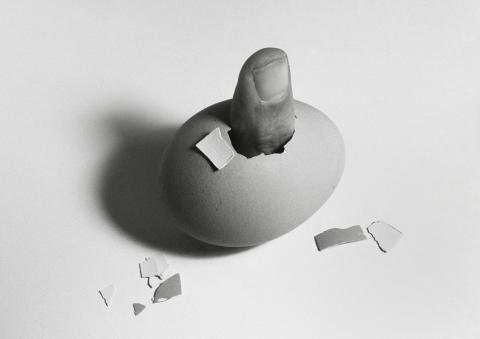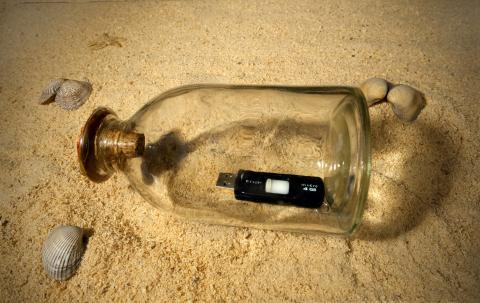
Fue en el 2009 que pude disfrutar por primera vez de las metáforas visuales del fotógrafo gallego Román Montesinos, con su exposición “Esta guerra no prospera”, en la Asociación Alexandre Bóveda, de A Coruña. A partir de esa muestra me convertí en un fiel seguidor de su obra. La muestra presentaba composiciones inusuales e imágenes que, con una simbiosis artística, provocativa y desafiante entre diferentes objetos y símbolos, combinaban una mordaz ironía.
Desde ese momento, quede admirado del gran talento creativo y la imaginación desbordante de Román, por ser un consumado artista, que con sus fotos, llenas de humor y absurdo, creadas a partir de ideas que iluminan su mente, no dejan indiferente a los espectadores.
En aquella ocasión Román me expresó: “La fotografía es magia. Es modelar con el ojo y la mente. Es captar la atención de extraños y dejarles una impronta. La imagen es una poderosa herramienta de comunicación y de transmisión de vivencias, pensamientos, conformados según la realidad de quien los transmite”.
“El espectador ante mis fotos verá contingencias entre objetos y la suplantación de unos objetos y su marco original, por otros. Observará, en definitiva, otra forma de ver las cosas y su entorno, y podrá comprender que la visión de lo que nos rodea puede tener distintas interpretaciones o significados –manifestó Román
El interés de este artista no es fotografiar lo que ve sino crear los objetos que quiere fotografiar, imágenes preconcebidas mentalmente. Genera imágenes insólitas en las cuales objetos cotidianos son modificados dándoles un sentido poético, creando una dialéctica entre lo real y lo virtual
En aquellos años Román era profesor de geología y paleontología de la Universidad de A Coruña, (ya hoy en día está jubilado) y estaba muy acostumbrado a ver cosas que la gente no observa normalmente, evidenciar pequeños detalles, a buscar analogías, comparar, contrastar ideas...es decir todo aquello que es común a una actividad científica en la que la filosofía tiene gran presencia.
“El proceso de ver algo, de revelarlo, es como un “flashazo”.
“Puedes buscar o puedes ver directamente algo dependiendo del momento. Son asociaciones de ideas, cruces neuronales… chispas si quieres llamarle así. El instante final es la representación de la idea y eso puede resultar, en muchas ocasiones, bastante complejo”.
“En este punto ya intervienen herramientas, composiciones, cámara, objetivo adecuado… toda esa melé es ya, en cierto punto, independiente de la idea que ha surgido… es el lenguaje que hay que crear para expresarla”, asegura Román.
Nada es banal para Román y sorprende ver cómo sus fotos, donde emplea los más variados objetos para expresar sus conceptos, nos muestran un mundo singular que nos hace ejercitar la mente. Román ratifica con sus fotos que el humor es un asunto muy serio.
“Me encanta el humor gallego –dice-, que es muy parecido en bastantes rasgos al humor inglés, con mucha ironía y “retranca”, y lo empleo en mis fotos. El humor puede ser un espejo distorsionador de situaciones, actitudes, filias y fobias de nuestra sociedad, y pienso que es necesario ser crítico en lo posible. Ahora bien, no acepto el humor chabacano o hiriente sin más motivo que el de lastimar”, puntualiza .
Sus fotos han sido apreciadas en exposiciones realizadas en numerosas localidades de Galicia, también en León, Oviedo, Gijón, Cantabria, y en la Casa de Galicia en Madrid, entre otros lugares. También ha ganado aplausos internacionales en la Casa Museo del Humor de Gabrovo, y en Veliko Tarnovo, Bulgaria; en Chaves, y en Castelo de Paiva, Portugal y en Tabriz, Irán.












Visual humor: Román Montesinos and his overflowing imagination
By Francisco Puñal Suárez
It was in 2009 that I was able to enjoy for the first time the visual metaphors of the Galician photographer Román Montesinos, with his exhibition “This war does not prosper”, at the Alexandre Bóveda Association, in A Coruña. From that exhibition I became a faithful follower of his work. The exhibition presented unusual compositions and images that, with an artistic, provocative and challenging symbiosis between different objects and symbols, combined a biting irony.
From that moment on, I was amazed by Román's great creative talent and overflowing imagination, for being an accomplished artist, who with his photos, full of humor and absurdity, created from ideas that illuminate his mind, do not leave viewers indifferent. .
On that occasion Román told me: “Photography is magic. It is modeling with the eye and the mind. It's capturing the attention of strangers and leaving an impression on them. The image is a powerful tool of communication and transmission of experiences and thoughts, shaped according to the reality of the person transmitting them.”
“The viewer of my photos will see contingencies between objects and the impersonation of some objects and their original frame by others. In short, you will observe another way of seeing things and your environment, and you will be able to understand that the vision of what surrounds us can have different interpretations or meanings – said Román
This artist's interest is not in photographing what he sees but in creating the objects he wants to photograph, mentally preconceived images. It generates unusual images in which everyday objects are modified giving them a poetic meaning, creating a dialectic between the real and the virtual.
In those years Román was a professor of geology and paleontology at the University of A Coruña, (now he is retired) and he was very used to seeing things that people do not normally observe, highlighting small details, looking for analogies, comparing, contrasting. ideas...that is, everything that is common to a scientific activity in which philosophy has a great presence.
“The process of seeing something, of revealing it, is like a “flash.”
“You can search or you can directly see something depending on the moment. They are associations of ideas, neural crossings... sparks if you want to call them that. The final moment is the representation of the idea and that can be, on many occasions, quite complex.”
“At this point, tools, compositions, camera, appropriate lens are already involved… all this scrum is already, at a certain point, independent of the idea that has emerged… it is the language that must be created to express it,” says Román.
Nothing is banal for Román and it is surprising to see how his photos, where he uses the most varied objects to express his concepts, show us a unique world that makes us exercise our minds. Román confirms with his photos that humor is a very serious matter.
“I love Galician humor,” he says, “which is very similar in many ways to English humor, with a lot of irony and “retranca,” and I use it in my photos. Humor can be a distorting mirror of situations, attitudes, philias and phobias of our society, and I think it is necessary to be critical as much as possible. Now, I do not accept vulgar or hurtful humor for no other reason than to hurt,” he points out.
His photos have been appreciated in exhibitions held in numerous locations in Galicia, also in León, Oviedo, Gijón, Cantabria, and in the Casa de Galicia in Madrid, among other places. He has also won international acclaim at the Gabrovo House Museum of Humor, and in Veliko Tarnovo, Bulgaria; in Chaves, and in Castelo de Paiva, Portugal and in Tabriz, Iran.
(This text has been translated into English by Google Translate)
